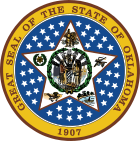Executive Branch Reform Act of 1986
 |
|
|---|---|
| Executive Branch Reform Act of 1986 | |
| Full title | Executive Branch Reform Act of 1986 |
| Acronym / colloquial name | EBRA |
| Effective | June 6, 1986 |
| Purpose | |
| Purpose | Organized a cabinet system appointed by the Governor which serves as an important informational link to the various departments, agencies, boards, commissions and other entities of the state's executive branch by establishing the Oklahoma State Cabinet. |
| Citations | |
| State Law | 74 O.S. Section 10.1 |
| Codification | |
| Title(s) amended | Title 74 (State Government) |
| Oklahoma Code sections created | Sections 10.1 - 10.4 |
| Legislative history | |
|
|
The Executive Branch Reform Act of 1986 (74 O.S. Sections 10.1–10.4) is an Oklahoma state law that requires the Governor of Oklahoma to organize the various 500 or more departments, agencies, boards, commissions and other entities of the state's executive branch into a cabinet system. The act grouped state agencies into clusters with an informational link to a cabinet secretary. But the legislation stopped short of consolidating agencies or the decision-making authority of the agencies, boards and commissions.
For example, the State Transportation Secretary, Gary Ridley as cabinet secretary, does not have direct statutory authority over either the State Highway Commission (and its Director) or the State Turnpike Authority (and its Director). However, Ridley concurrently holds all 3 titles so at the present time authority is consolidated, albeit in a temporary ad hoc manner.
Similarly, the Secretary of Education has no authority over the State Department of Education, State Regents for Higher Education, CareerTech Department or State Chancellor for Higher Education.
The Executive Branch Reform Act was signed into law by Governor George Nigh on June 6, 1986.
The executive branch of the government of Oklahoma continues to be divided into some 500 different departments, agencies, board and commissions, with each appointed commission member appointed by and(in theory) answering directly to the Governor of Oklahoma. For example, a 7-member board will become controlled by the new Governor after he appoints 4 members, which in most cases will occur in the 4th year of the Governor's term of office.
To help better coordinate the actions of the executive branch, Governor David L. Boren began holding semi-official and semi-regular meetings with various heads of State agencies. Boren's successor, Governor George Nigh appointed the Nigh Commission to make recommendations to improve the efficiency of the State government. Following the Commission's report, Nigh pushed the Oklahoma Legislature to address these structural problems. The result was the Executive Branch Reform Act of 1986, which established a Cabinet system for the executive branch, and establish the Oklahoma State Cabinet with structured meetings with and reports to the Governor. However, the Cabinet members can influence but do not directly supervise or control the various 500 plus agencies, boards or commissions in the State Government of Oklahoma.
...
Wikipedia
